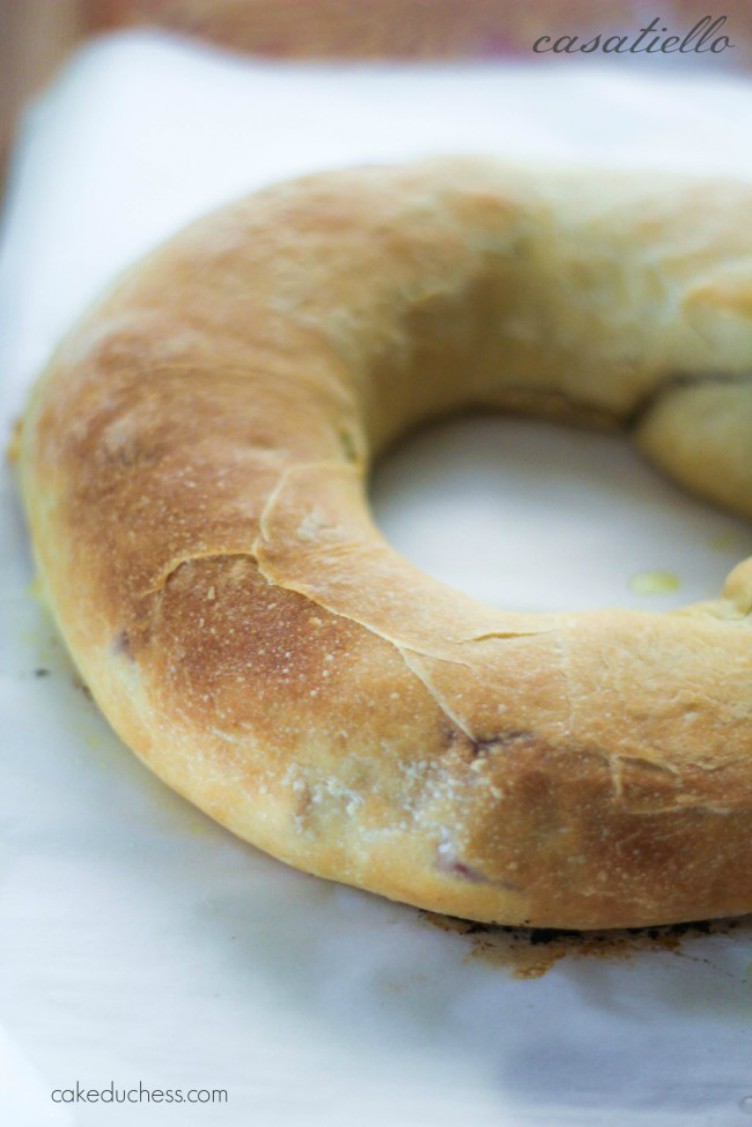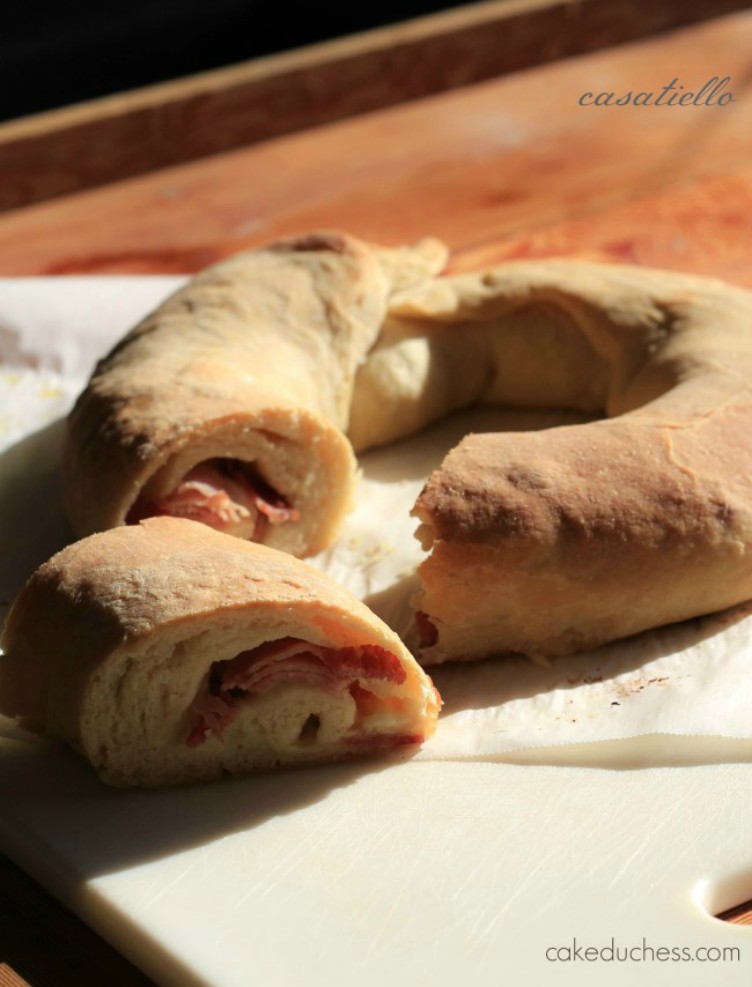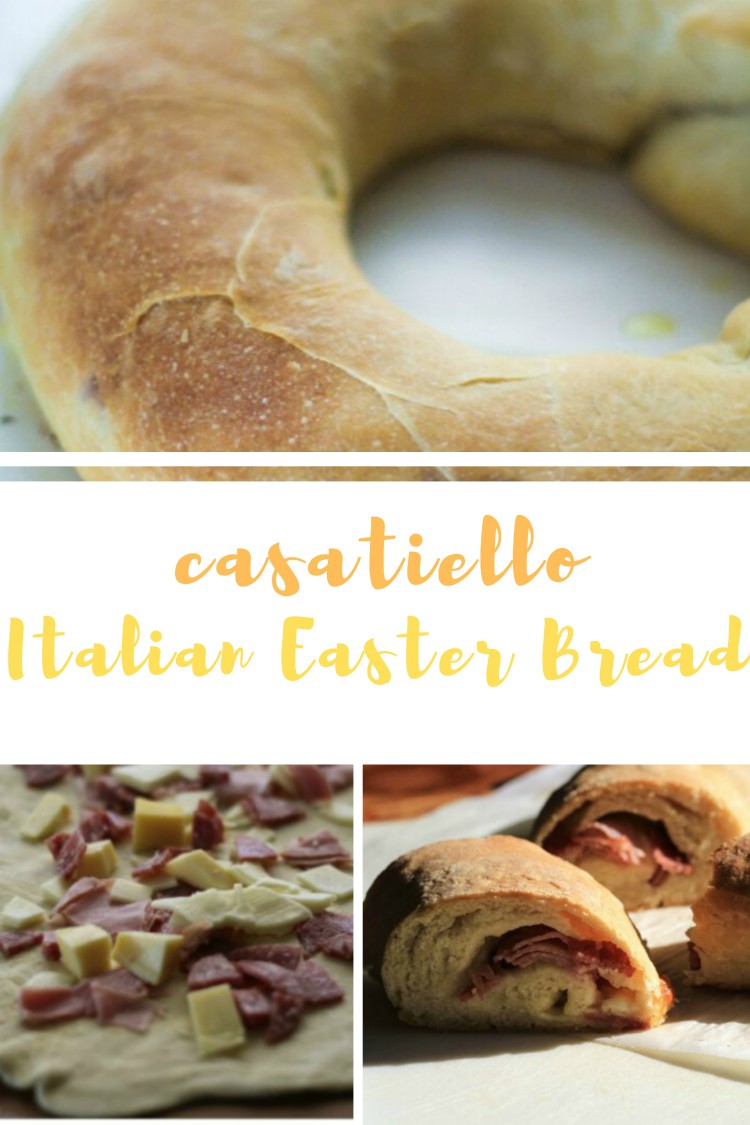Casatiello is a delicious stuffed Italian Easter Bread. It is a traditional savory Napoletano Easter bread from the Campania region of Italy. It is made with a simple pizza dough and filled with cheese and cured meats. Perfect to bring along on a Pasquetta (Easter Monday) picnic!

As with any holiday, I find an excuse to bake an Italian bread. My other goal during the holidays is to find the time to take a few photos of what I created and capture the bread moment to share here with all of you, like this wonderful donut-shaped bread called casatiello.
Casatiello stands distinct from its relative, tortano, in that the former requires eggs to be placed atop the dough and encased with a cross of more bread prior to baking.
Jump To
- Casatiello -A Delicious Stuffed Italian Easter Bread
- Why you'll love this Casatiello Napoletano?
- What is a typical Italian Easter bread called?
- When to eat this bread on Easter?
- History of the Neapolitan Easter Bread
- What ingredients do you need for a Casatiello Napoletano?
- How do you make a stuffed Italian Easter bread?
- how to activate yeast step 1: warm water
- how to activate yeast step 2: add a little sugar
- how to activate yeast step 3: give it time
- what if my yeast isn’t foaming?
- FAQ'S
- Casatiello
Casatiello -A Delicious Stuffed Italian Easter Bread
Originally published April 7, 2015, updated on March 4, 2023.
Growing up in an Italian family, I learned the lessons of "waste not, want not. I live it now as an adult getting to spend time with my in-laws in Italy and when they come to visit us here.
My mother-in-law is the queen of finishing every last ingredient before going to buy something new. Another famous Italian Easter bread is the Crescia al Formaggio-Italian Easter Cheese Bread. And our family favorite is the Pane di Pasqua-Italian Easter Bread that is stuffed with eggs.
As my Sicilian father did, Teresa embraces wholeheartedly "la cucina povera" (translated literally: poor kitchen or the kitchen of the poor), but I like to think of it as the creative genius of a home cook that uses simple ingredients that result in incredible dishes and flavors.
Why you'll love this Casatiello Napoletano?
- Ideal choice for those who are looking for a delicious and hearty Italian dish.
- This traditional Easter loaf combines savory eggs, salami, and cheese in a soft dough.
- The result is a rich and flavorful treat that you won't be able to resist!
- It can be served as a snack or appetizer.

I always have on hand some ham, different cheeses and salami. I have made different breads with these ingredients, not just for the holidays. But since it was Easter, and a new #TwelveLoaves challenge, I decided to bake a casatiello: a Neapolitan Easter bread. This month #TwelveLoaves bakers are baking with CHEESE...and who doesn't love cheese?!?

It seems there are different versions of this bread in the area of Italy of Naples (Campania) that are made for Easter. During Easter, it has eggs nestled on top and they have crosses made from dough criss-crossing on top of them. I think that this bread actually should be a called a ciambella rustica salata (or a tortano napoletano)
What is a typical Italian Easter bread called?
I have also seen it called a baba' salato.
I do know that in the Campania region they are made with eggs stuffed inside with the filling, or placed on top (as I mentioned above). I chose to stick with calling this a casatiello, because Teresa told me a friend from Naples taught her how to make it.
When to eat this bread on Easter?
It is perfect served as an antipasto for Easter dinner. Any leftovers? It tastes so good even the next day!! If you are in Italy, and are lucky enough to have Pasquetta (the Monday after Easter-Easter Monday), this is what you could pack on your picnic in the mountains.
History of the Neapolitan Easter Bread
The history of the rustico dish dates back hundreds of years and has its origins in ancient Greece. The first references to bread seasoned with various ingredients, called plakountes, can be found in Greek culture.
A similar type of bread, known as focaccia, was even used as an offering to Demeter. The Roman word for this bread, with some local variations, adds the adjective caseata, from the Latin word caseus.
Although the rustico is traditionally served during Easter, it is not eaten until Holy Saturday and must not be consumed before that day. It is removed from the table on Easter Monday during lunch.
In Naples, the rustico should not be eaten before Saturday due to the conclusion of the Easter Triduum, a period of mourning for the church. The end of fasting is celebrated with the resurrection of Christ, and meats and desserts are returned to the table at home.
What ingredients do you need for a Casatiello Napoletano?
- bread flour- plus more for rolling
- sugar
- instant dry yeast
- kosher salt
- water 110 degrees F
- olive oil plus
- sliced ham diced small
- soft salami diced small
- provolone cheese diced small
- fontina cheese diced small
- finely chopped rosemary
How do you make a stuffed Italian Easter bread?
- In a small bowl, add the water and sprinkle the yeast on top of the water. Sprinkle on the sugar and 1 tablespoon of the oil and whisk together. Set aside until the yeast bubbles (about 10 minutes).
- Brush another large bowl with 2 teaspoons olive oil.
- In the bowl with yeast, whisk the rest of the olive oil, and salt. Make a well in the middle of the flours and pour in the yeast mixture. Stir with a wooden spoon until a sticky dough forms.
- Form the dough into a ball and place into the oiled bowl (when I put the dough in the bowl I swish the dough around the bottom of the bowl and then flip it over so all of the dough is covered in a light film of oil).
- Cover with a towel and let it rise at room temperature until doubled in size (about 1-1 1/2 hours).
- When dough is ready, roll it out to a rectangle about 16x20 inches (about 1/10 inch thick)and cut the ends to make it even.
- Sprinkle the filling ingredients on top of the dough leaving a 1 inch border.
- Roll the dough like a jelly roll. Cut the ends so it is even and pinch the dough around the seams to seal it.
- Bring the two ends together to make a ring and seal them closed. Place the ring on a parchment lined baking sheet.
- Let the dough rest covered with a towel for about 30 minutes.
- While the dough is resting, heat the oven to 375F.
- When ready to bake, brush the dough with the remaining olive oil.
- Bake until golden brown (about 30 minutes).

I made a simple pizza dough and stuffed it with ham, salami, provolone cheese and leftover gruyere. Can I tell you how wonderful this easy dough filled with simple ingredients is? Simply fantastico! It was a hit at Easter and it is a hit whenever I bake it (I don't make it just for Easter).
You could use the measurements as your guide. My mother-in-law makes the dough by eye and by feeling and adjusts according to how the texture is. Enjoy the filling by really making it your own (add more or less cheese, mix up the meet filling as you like it).
how to activate yeast step 1: warm water
Check the date on the package and make sure the yeast is not expired. That's the most important step. Then sprinkle it over the warm water. The water is about 110F. You could test the temperature also with the back of your wrist (like when you’re testing a baby’s bottle of milk…warm and not scalding)or you could use a thermometer.
how to activate yeast step 2: add a little sugar
Next, add a teaspoon of sugar. The sugar does help the yeast to begin to activate. It should start to foam up in no time.
how to activate yeast step 3: give it time
The yeast does activate sooner in a warmer kitchen. It could be ready to use in 5 minutes. It could also take a full 15 minutes if your kitchen is a little chiller.
what if my yeast isn’t foaming?
It may happen that by 15 minutes the yeast did not activate and begin to foam. I always have extra yeast packets on hand. Toss out that batch and start over with new warm water and fresh packet of yeast. Maybe your water was too hot. Maybe that packet was not fresh (it's happened to me!). Just start over, no problem.
FAQ'S
Casatiello is a traditional Italian savory bread that is typically eaten during Easter in Naples and surrounding regions. It is made with a yeasted dough that is flavored with cheese, cured meats, and often, eggs.
The ingredients of casatiello can vary slightly depending on the recipe and region, but typically include flour, yeast, water, salt, cheese (usually pecorino or Parmesan), cured meats (such as salami or pancetta), and eggs.
To make casatiello, the dough is first prepared by mixing flour, yeast, water, and salt. Once the dough has risen, it is flavored with cheese, cured meats, and eggs, which are mixed in and then formed into a ring shape. The bread is then baked until golden brown.
Casatiello is a traditional Easter dish in Naples and surrounding regions, and is often served on Easter Sunday or Monday. The ring shape of the bread is said to represent the crown of thorns worn by Jesus during his crucifixion, while the eggs symbolize new life and rebirth.
Yes, casatiello can be frozen. To freeze, wrap the bread tightly in plastic wrap and then in aluminum foil or a freezer bag. When ready to eat, allow the bread to thaw at room temperature before reheating in the oven.
Casatiello is best eaten fresh, but can be stored in an airtight container at room temperature for up to 2-3 days. It can also be refrigerated for up to a week, but may lose some of its flavor and texture over time.
Yes, it is possible to make casatiello vegan or gluten-free by using plant-based ingredients and gluten-free flour. However, it may require some experimentation to get the texture and flavor just right.
#TwelveLoaves is a monthly bread baking party created by Lora from Savoring Italy.
Our theme is CHEESE. Look at all these other fantastic cheese breads!
- Buttermilk Goat Cheese Biscuits from That Skinny Chick Can Bake
- Casatiello from Savoring Italy
- Cheddar Chive Bread from Karen's Kitchen Stories
- Cheddar Dill Twists from blackberry eating in late september
- Cheese Babka from Hostess At Heart
- Cheese Soda bread from Ma che ti sei mangiato
- Cream Cheese and Cherry Buns from girlichef
- Feta & Olive Swirls from The Bread She Bakes
- Khachapuri (Georgian Cheese Bread) from A Shaggy Dough Story
- Pimento Cheese Straws from Kudos Kitchen By Renee
Pin for later!

Did you make this? Please RATE THE RECIPE below:)
Please Subscribe and give a follow on Instagram, Facebook, Pinterest, and TikTok xx
Casatiello
Ingredients
- DOUGH
- 3 1/2 to 4 cups bread flour plus more for rolling
- 1 teaspoon sugar
- 1 envelope instant dry yeast
- 2 teaspoons kosher salt
- 1 1/2 cups water 110 degrees F
- 3 tablespoons olive oil plus 4 teaspoons
- FILLING
- 1/2 cup sliced ham diced small
- 1/3 cup soft salami diced small
- 1/4 cup provolone cheese diced small
- 1/2 cup fontina cheese diced small
- 1 Tbsp. finely chopped rosemary
Instructions
- In a small bowl, add the water and sprinkle the yeast on top of the water. Sprinkle on the sugar and 1 tablespoon of the oil and whisk together. Set aside until the yeast bubbles (about 10 minutes).
- Brush another large bowl with 2 teaspoons olive oil.
- In the bowl with yeast, whisk the rest of the olive oil, and salt. Make a well in the middle of the flours and pour in the yeast mixture. Stir with a wooden spoon until a sticky dough forms.
- Form the dough into a ball and place into the oiled bowl (when I put the dough in the bowl I swish the dough around the bottom of the bowl and then flip it over so all of the dough is covered in a light film of oil).
- Cover with a towel and let it rise at room temperature until doubled in size (about 1-1 1/2 hours).
- When dough is ready, roll it out to a rectangle about 16x20 inches (about 1/10 inch thick)and cut the ends to make it even.
- Sprinkle the filling ingredients on top of the dough leaving a 1 inch border.
- Roll the dough like a jelly roll. Cut the ends so it is even and pinch the dough around the seams to seal it.
- Bring the two ends together to make a ring and seal them closed. Place the ring on a parchment lined baking sheet.
- Let the dough rest covered with a towel for about 30 minutes.
- While the dough is resting, heat the oven to 375F.
- When ready to bake, brush the dough with the remaining olive oil.
- Bake until golden brown (about 30 minutes).
Nutrition Disclaimer
Please keep in mind that the nutritional information presented below is an approximation and may vary depending on the exact ingredients used.




Olivia says
This bread looks incredible!
Dorothy Reinhold says
I think this would be a wonderful appetizer at any party! Meat, cheese, and bread seem like a perfect combo to me.
Deseree says
This Easter bread sounds amazing and perfect for the upcoming holiday! I can't wait to add it to my Easter menu.
Jacque Hastert says
Easter bread is one of my most favorite things to make this time of year. I can't wait to make this again.
Katerina @ diethood .com says
Oh my, this Easter bread sounds INCREDIBLE!!! I can't wait to try this recipe!
Chrissie Baker says
Hmmm…This looks yummy! Thanks for sharing your recipe! I would love to try this for the Easters! Thanks!
Ann marie says
Do you think this Easter bread can be made with ready made dough? Our local bakery sells it ? And would I need to rest it after I shaped it into the ring or just bake ? Thanks for this wonderful recipe
Lora says
Hi Ann Marie-yes, it should turn out fine with the dough from your local bakery. I would let it rest like the recipe explains. Buona Pasqua! XX
Laura says
hello, my family originated in Sicily. every st Joseph's Day we make What we call "barooney". someone came up with the real spelling, we think "pituni" but none of us are sure. my mom 87 has passed this yo us. Angelina remembers her mother making them. and frying them . dough, salami, provalone, and a dressed chicory. folded individually. chicory has black olives, olive oil and salt and pepper. sound very similar to yours. any correct spelling for us? pleasure to read your experiences!
Lora says
Hi Laura I never heard of barooney or pituni...there could be variations on a recipe name from even village to village in Sicily. Your mom's recipe sounds so delicious. Love the olives in chicory idea! Fabulous! Please let me know if you find out the name (maybe if you research which part of Sicily your family is from, you could find the original name/recipe). XX
Candace says
Hi! I believe what you’re looking for is Pitoni Messinesi! They fill them with all sorts of things depending on the region! Hope this helps!